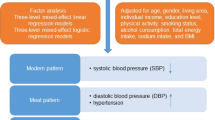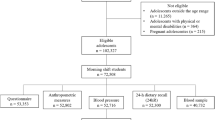Abstract
Background/Objectives
This study investigated the association between frequency of having breakfast and dyslipidemia in South Korean adults aged 30 or over.
Subjects/Methods
This study, including 10,874 participants, was based on the Seventh Korea National Health and Nutrition Examination Survey conducted between 2013 and 2016. Using multiple logistic regression analysis, we examined the associations between frequency of having breakfast (and other covariates) and dyslipidemia in men and women.
Results
Dyslipidemia was more common among male participants with lower frequency of having breakfast in a week and was significantly high in “0 times a week” group (OR = 1.42, 95% CI, 1.13–1.78) compared with 5–7 times/week. This trend was observed in those aged 40–59 years, white collar workers, those living with their spouse, and overweight or obese participants among males and in females aged 40–49 and ≥ 60 years. Statistically significant tendency of having dyslipidemia was observed with decreasing frequency of having breakfast in total cholesterol, low-density lipoprotein cholesterol (LDL-C), and triglycerides in males (LDL-C: p for trend < 0.0001, TG: p for trend = 0.0004), but not in females.
Conclusion
Frequency of having breakfast was associated with reduced dyslipidemia rate. The risk of dyslipidemia with a low frequency of breakfast was particularly observed in males aged 40–59, white collar workers, those living with a spouse, and postmenopausal females aged ≥ 60.
This is a preview of subscription content, access via your institution
Access options
Subscribe to this journal
Receive 12 print issues and online access
$259.00 per year
only $21.58 per issue
Buy this article
- Purchase on Springer Link
- Instant access to full article PDF
Prices may be subject to local taxes which are calculated during checkout

Similar content being viewed by others
References
Beaglehole R, Bonita R, Horton R, Adams C, Alleyne G, Asaria P. et al. Priority actions for the non-communicable disease crisis. Lancet. 2011;377:1438–47.
Lozano R, Naghavi M, Foreman K, Lim S, Shibuya K, Aboyans V, et al. Global and regional mortality from 235 causes of death for 20 age groups in 1990 and 2010: a systematic analysis for the Global Burden of Disease Study 2010. Lancet. 2012;380:2095–128.
Committee for the Korean Guidelines for the Management of Dyslipidemia. 2015 Korean guidelines for the management of dyslipidemia: executive summary (English translation). Korean Circ J. 2016;46:275–306.
Statistics Korea. Annual report on the cause of death statistics. Statics Korea: Daejeon, 2016.
Lee MH, Kim HC, Ahn SV, Hur NW, Choi DP, Park CG, et al. Prevalence of dyslipidemia among Korean adults: Korea National Health and Nutrition Survey 1998-2005. Diabetes Metab J. 2012;36:43–55.
Kim HC. Epidemiology of dyslipidemia in Korea. J Korean Med Assoc. 2016;59:352–7.
Ha KH, Kwon H-S, Kim DJ. Epidemiologic characteristics of dyslipidemia in Korea. J Lipid Atheroscler. 2015;4:93–99.
The Korean Society of Lipid and Atherosclerosis. Dyslipidemia fact sheet in Korea 2015 [Internet]. In: Seoul: Korean Society of Lipidology and Atherosclerosis Dyslipidemia, 2015.
van Reedt Dortland AK, Vreeburg SA, Giltay EJ, Licht CM, Vogelzangs N, van Veen T, et al. The impact of stress systems and lifestyle on dyslipidemia and obesity in anxiety and depression. Psychoneuroendocrinology. 2013;38:209–18.
Roh E, Ko S-H, Kwon H-S, Kim NH, Kim JH, Kim CS, et al. Prevalence and management of dyslipidemia in Korea: Korea National Health and Nutrition Examination Survey during 1998 to 2010. Diabetes Metab J. 2013;37:433–49.
Nam GE, Cho KH, Park YG, Han KD, Choi YS, Kim SM, et al. Socioeconomic status and dyslipidemia in Korean adults: The 2008–10 Korea National Health and Nutrition Examination Survey. Prev Med. 2013;57:304–9.
Michalsky MP, Inge TH, Simmons M, et al. Cardiovascular risk factors in severely obese adolescents: the teen longitudinal assessment of bariatric surgery (teen-labs) study. JAMA Pediatr. 2015;169:438–44.
Perk J, De Backer G, Gohlke H, Graham I, Reiner Z, Verschuren M, et al. European Guidelines on cardiovascular disease prevention in clinical practice (version 2012). The Fifth Joint Task Force of the European Society of Cardiology and Other Societies on Cardiovascular Disease Prevention in Clinical Practice (constituted by representatives of nine societies and by invited experts). Eur Heart J. 2012;33:1635–701.
Executive Summary of The Third Report of The National Cholesterol Education Program (NCEP). Expert panel on detection, evaluation, and treatment of high blood cholesterol in adults (Adult Treatment Panel III). JAMA. 2001;285:2486–97..
Goff DC, Lloyd-Jones DM, Bennett G, Coady S, D’Agostino RB, Gibbons R et al. 2013 ACC/AHA Guideline on the assessment of cardiovascular risk. A Report of the American College of Cardiology/American Heart Association Task Force on Practice Guidelines. Circulation. 2013;129:S1–S45.
Grundy SM, Cleeman JI, Merz CNB, Brewer HB, Clark LT, Hunninghake DB, et al. Implications of recent clinical trials for the National Cholesterol Education Program Adult Treatment Panel III Guidelines. Circulation. 2004;110:227–39.
Lee JB, Yi HY, Bae KH. The association between periodontitis and dyslipidemia based on the fourth Korea National Health and Nutrition Examination Survey. J Clin Periodontol. 2013;40:437–42.
Kweon S, Kim Y, Jang M, Kim Y, Kim K, Choi S, et al. Data Resource Profile: the Korea National Health and Nutrition Examination Survey (KNHANES). Int J Epidemiol. 2014;43:69–77.
Statistics Korea. Results of the 2015 Population and Housing Census Sampling (female, fertility, children, housing). Population Census Division: Daejeon: Statistics Korea, 2017.
Atsma F, Bartelink M-LEL, Grobbee DE, van der Schouw YT. Postmenopausal status and early menopause as independent risk factors for cardiovascular disease: a meta-analysis. Menopause. 2006;13:265–79.
Schnatz PF, Schnatz JD. Dyslipidemia in menopause: mechanisms and management. Obstet Gynecol Surv. 2006;61:608–13.
Welty FK. Cardiovascular disease and dyslipidemia in women. Arch Intern Med. 2001;161:514–22.
Costa G, Sartori S. Ageing, working hours and work ability. Ergonomics. 2007;50:1914–30.
Chandra RK. Nutrition and the immune system from birth to old age. Eur J Clin Nutr. 2002;56:S73.
Chae DH, Kim SH, Lee CY. A Study on gender differences in influencing factors of office workers’ physical activity. J Korean Acad Community Health Nurs. 2013;24:273–81.
U.S. Department of Health and Human Services. Physical activity and health: a report of the surgeon general. Atlanta. U.S. Department of Health and Human Services, Centers for Disease Control and Prevention, National Center for Chronic Disease Prevention and Health Promotion, 1996.
Steele R, Mummery K. Occupational physical activity across occupational categories. J Sci Med Sport. 2003;6:398–407.
Salmon J, Owen N, Bauman A, Schmitz MK, Booth M. Leisure-time, occupational, and household physical activity among professional, skilled, and less-skilled workers and homemakers. Prev Med. 2000;30:191–9.
Tammelin T, Nayha S, Rintamaki H, Zitting P. Occupational physical activity is related to physical fitness in young workers. Med Sci Sports Exerc. 2002;34:158–65.
Wu B, Porell F. Job characteristics and leisure physical activity. J Aging Health. 2000;12:538–59.
Guimont C, Brisson C, Dagenais GR, Milot A, Vézina M, Mâsse B, et al. Effects of job strain on blood pressure: a prospective study of male and female white-collar workers. Am J Public Health. 2006;96:1436–43.
Taylor RS, Brown A, Ebrahim S, Jolliffe J, Noorani H, Rees K, et al. Exercise-based rehabilitation for patients with coronary heart disease: systematic review and meta-analysis of randomized controlled trials. Am J Med. 2004;116:682–92.
Kraus WE, Houmard JA, Duscha BD, Knetzger KJ, Wharton MB, McCartney JS, et al. Effects of the amount and intensity of exercise on plasma lipoproteins. N Engl J Med. 2002;347:1483–92.
Blair SN, Haskell WL. Objectively measured physical activity and mortality in older adults. JAMA. 2006;296:216–8.
Grabauskas V, Miseviciene I, Klumbiene J, Petkeviciene J, Milasauskiene Z, Plieskiene A, et al. Prevalence of dyslipidemias among Lithuanian rural population (CINDI program). Med (Kaunas). 2003;39:1215–22.
Brown CD, Higgins M, Donato KA, Rohde FC, Garrison R, Obarzanek E, et al. Body mass index and the prevalence of hypertension and dyslipidemia. Obes Res. 2000;8:605–19.
Foucan L, Kangambega P, Ekouevi DK, Rozet J, Bangou-Bredent J. Lipid profile in an adult population in Guadeloupe. Diabetes Metab. 2000;26:473–80.
Mataix J, Lopez-Frias M, Martinez-de-Victoria E, Lopez-Jurado M, Aranda P, Llopis J. Factors associated with obesity in an adult Mediterranean population: influence on plasma lipid profile. J Am Coll Nutr. 2005;24:456–65.
Casazza K, Fontaine KR, Astrup A, Birch LL, Brown AW, Bohan Brown MM, et al. Myths, presumptions, and facts about obesity. N Engl J Med. 2013;368:446–54.
Eckel RH. Nonsurgical management of obesity in adults. N Engl J Med. 2008;358:1941–50.
Poobalan A, Aucott L, Smith WC, Avenell A, Jung R, Broom J, et al. Effects of weight loss in overweight/obese individuals and long-term lipid outcomes--a systematic review. Obes Rev. 2004;5:43–50.
Mensink RP, Zock PL, Kester AD, Katan MB. Effects of dietary fatty acids and carbohydrates on the ratio of serum total to HDL cholesterol and on serum lipids and apolipoproteins: a meta-analysis of 60 controlled trials. Am J Clin Nutr. 2003;77:1146–55.
Brown L, Rosner B, Willett WW, Sacks FM. Cholesterol-lowering effects of dietary fiber: a meta-analysis. Am J Clin Nutr. 1999;69:30–42.
Marshall DW, Anderson AS. Proper meals in transition: young married couples on the nature of eating together. Appetite. 2002;39:193–206.
Zlabek JA, Grimm MS, Larson CJ, Mathiason MA, Lambert PJ, Kothari SN. The effect of laparoscopic gastric bypass surgery on dyslipidemia in severely obese patients. Surg Obes Relat Dis. 2005;1:537–42.
Acknowledgements
By submitting a written statement and data utilization plan, the KNHANES data are openly available at https://knhanes.cdc.go.kr/knhanes/index.do.
Author information
Authors and Affiliations
Contributions
DWL and ECP designed the research. DWL and DWC conducted the research and analyzed data. DWL wrote the paper. ECP had primary responsibility for the final content. All authors read and approved the final manuscript. This study was not funded by any industrial, commercial, or governmental sources.
Corresponding author
Ethics declarations
Conflict of interest
Informed consent was obtained from all participants. The authors declare that they have no conflict of interest.
Rights and permissions
About this article
Cite this article
Lee, D.W., Choi, DW., Ju, Y.J. et al. The association between low frequency of having breakfast and dyslipidemia in South Korean men and women. Eur J Clin Nutr 73, 896–904 (2019). https://doi.org/10.1038/s41430-018-0289-5
Received:
Revised:
Accepted:
Published:
Issue Date:
DOI: https://doi.org/10.1038/s41430-018-0289-5
This article is cited by
-
Breakfast consumption frequency is associated with dyslipidemia: a retrospective cohort study of a working population
Lipids in Health and Disease (2022)



